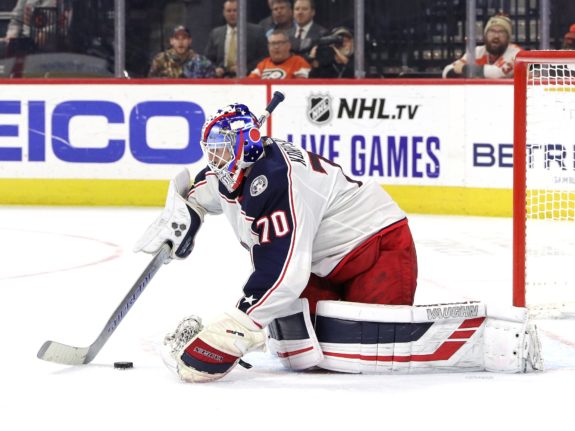One of the most glaring issues facing the Columbus Blue Jackets this season has been the defense’s inconsistent play. To make the defensive problems even more shocking, the team had one of the strongest units last season.
The question is, are they actually worse than last season? This piece will compare this season’s defense to last season’s and discuss what has led to these inconsistencies.
Blue Jackets Defensively Last Season vs. This Season
There is no better way to compare their defense from last season to this season than to look at stat changes. Below will be multiple defensive statistic categories, and we will look at how their differences between the two seasons.
The Blue Jackets are Giving Up More Goals
Last season, the Blue Jackets gave up just 183 goals against (GA), which was well below the NHL average (208 GA). That equated to a goals against average (GAA) of 2.61, which was also below the league mark (2.82) by .21%.
Related: Blue Jackets Still Looking For Defensive Consistency
This season, they have given up 68 goals in just 20 games and are on pace to give up approximately 204 goals. That adds up to a GAA of 3.40, well above last season’s average. This season’s GAA is much higher than the league average of 2.77.
When it comes to goals against, it is clear that the defensive corps is struggling much more this season than last. This is a worrisome trend when it comes to the possibility of making the Stanley Cup Playoffs.
Columbus’ Scoring Chances Against and High Danger Scoring Chances Against are Actually Lower
During the 2019-20 season, Columbus gave up a total of 2092 shots against (SA). That was below the league average of 2192 SA. When you average out those two figures, the Blue Jackets gave up 29.89 shots against/game (SA/G) and the league about 31.31 SA/G.
They also gave up 1380 scoring chances against (SCA), 382 of which were considered high danger chances against (HDA). That added up to 19.71 SCA/G (scoring chances against/game) and 5.46 HDA/G (high danger chances against/game).
This season they have given up 648 SA (32.4 SA/G), well higher than the NHL mark of 545 (27.25 SA/G). They have also given up a total of 249 SCA; 71 were HDA. This averages 12.45 SCA/G and 3.55 HDA/G.

Oddly enough, the Blue Jackets are giving up many more goals this season than last, yet they give up fewer scoring chances and high danger chances. Below will discuss the most glaring issue for the defense.
The Cause for the Blue Jackets’ Defensive Struggles
The most prevalent struggle for the Blue Jackets’ defense is their play in front of the goaltender. They have struggled with defensive zone turnovers, shot-blocking, and exiting the zone. On paper, the trouble they are having in the defensive zone shows.
When it comes to blocked shots, the Blue Jackets’ totals are down. Last season they had an average of 15.14 blocks/gam (BLK/G). This season that is down to 14.4 BLK/G.
In the 2019-20 season, the two leading shot blockers for the team (David Savard and Seth Jones) averaged 2.33 BLK/G and 1.76 BLK/G, respectively. This season both still lead the team, but Savard is averaging only two blocks, and Jones is averaging only 1.4.

The Blue Jackets have also struggled with the puck in the defensive zone. Last season, they gave up 3.94 defensive zone giveaways/game (DZG/G). So far this season, that has climbed up to 4.55 DZG/G.
The lack of puck control and play in front of the net is showing statistically for the team.
In 2019-20, the Blue Jackets’ defensemen combined for a plus-minus of minus-two. This season that has plunged to -12. Seth Jones had the highest plus-minus (plus-ten) last season; now he has one of the worst on the team (minus-eight).
Their save percentage (SV%) has also dropped from .913 last season to .895 now. Their penalty kill percentage (PK%) did as well, by nearly ten points, from 81.66% to 71.74%.
At first, you may think it is goaltending, but their inability to cleanly leave the zone has put both Elvis Merzlikins and Joonas Korpisalo in many precarious situations.
One of the best examples of this occurred on Tuesday’s 6-5 loss to the Chicago Blackhawks. Max Domi turned the puck over as he left the defensive zone, giving the Blackhawks a 2-0 break that ended in an easy goal for Patrick Kane.
Columbus’ Defensive Diagnosis
The Blue Jackets traded two of their best defensemen, Markus Nutivaara and Ryan Murray, in the offseason. Clearly, Zach Werenski being out for a large part of the season doesn’t help either. They also lost one of their most defensively solid forwards, Alexander Wennberg, to trade as well.

However, they are third-worst in the league in GA, are turning over the puck in the defensive zone, and are struggling on the penalty kill. At this point, they are 20 games into the season and should be starting to mesh together, but they aren’t.
As worrisome as this situation is for the fans and organization, the good news is they still have 36 games to play, the defense has the ability and talent to come together, and are just three points out of a playoff spot.
They are quickly running out of time to make a run, but if the defense finds their way soon, it is still quite possible they grab a playoff spot.